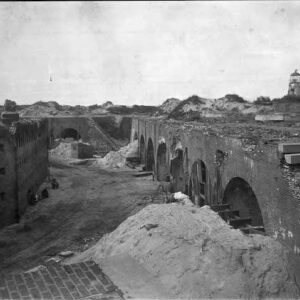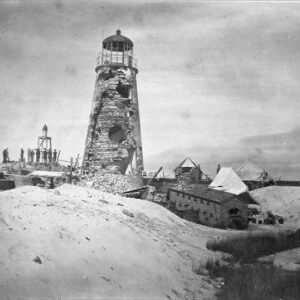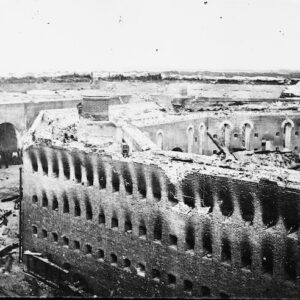Tag: Fort Morgan AL
Wikipedia says: Fort Morgan is a historic masonry pentagonal bastion fort at the mouth of Mobile Bay, Alabama, United States. Named for Revolutionary War hero Daniel Morgan, it was built on the site of the earlier Fort Bowyer, an earthen and stockade type fortification involved in the final land battles of the War of 1812. Construction was completed in 1834 and it received its first garrison in March of the same year.
Fort Morgan is at the tip of Mobile Point at the western terminus of State Route 180 (Alabama). It and Dauphin Island, on which Fort Gaines is situated, enclose Mobile Bay.
War of 1812
After the departure of the Spanish from Mobile in April 1813, the Americans built an earth and wood redoubt on Mobile Point, ultimately naming it Fort Bowyer after Col. John Bowyer, who completed the construction before leaving in 1814. In September 1814 the fort withstood a British naval and land attack, known as the First Battle of Fort Bowyer. The British returned in February 1815 after their defeat at the Battle of New Orleans and again launched an attack that became known as the Second Battle of Fort Bowyer. This time they were successful, with its American garrison surrendering the fort. Before the British could continue their attack towards Mobile they received word that the Treaty of Ghent, ending the war, had been signed on Christmas Eve, 1814. When word of the treaty’s ratification arrived shortly thereafter, the British withdrew. The site was a logical one for a more substantial fort that could defend itself from landward and protect the entrance to the bay, leading to Fort Morgan replacing Fort Bowyer.
Construction
After the War of 1812, the U.S. began a program to strengthen its seacoast defenses. As part of this program, in 1818 the U.S. contracted with Benjamin Hopkins of Vermont to build a large masonry fort on Mobile Point after a design by Simon Bernard, who had been a military engineer for Napoleon. However, Hopkins died a year later in a yellow fever epidemic, having accomplished little. The next contractor, Samuel Hawkins of New York, died in 1821, before accomplishing anything on the project. The Army turned the task over to the Corps of Engineers under Capt. R.E. De Russey. Using slave labor, DeRussey was able to make some progress before he took ill in 1825 and turned the work over to his deputy, Lieut. Cornelius Ogden. Ogden completed the work in March 1834 and turned the fort over to Capt. F.S. Belton, commander of Company B, 2nd US Artillery. This unit remained at the fort for about a year and a half before its transfer to Florida to assist in the Second Seminole War.
Civil War
Eight days before Alabama seceded from the Union, Col. John B. Todd took four companies of Alabama volunteers and captured the fort before dawn on 3 January 1861. The Confederates then proceeded to strengthen the defenses of Mobile Bay. The key point was the Main Ship Channel opposite Fort Morgan as this was the only approach where the water was deep enough to permit major warships to pass. To defend this area, the Confederates placed 18 of the fort’s heaviest guns (including two 7-inch Brooke rifles and two British-made 8-inch Blakely rifles), so that they could bear on the Channel. They also built redoubts and trenches east of the fort to impede further any attack via land. Lastly, they complemented the land defenses with a small flotilla consisting of the ram Tennessee, and three gunboats, Morgan, Gaines and Selma, all under the command of Admiral Franklin Buchanan.
During the war, Fort Morgan provided protective fire for blockade runners. All 17 vessels that ran out of the Bay eluded capture, as did 19 of the 21 that attempted to enter. Union soldiers were observed in the Sand Island Lighthouse, spying on Fort Morgan, and the fort fired on the position destroying the lighthouse.
During the Battle of Mobile Bay on August 5, 1864, Union naval forces under Admiral David G. Farragut were able to get past Fort Morgan and enter the Bay. They captured Tennessee and Selma, forced the beaching and burning of Gaines, and captured Fort Gaines. This freed the Union land forces under Gordon Granger to besiege Fort Morgan. During the siege, the wooden roof of the Citadel, a ten-sided barracks located in the center of the fort used to house the enlisted men, caught fire and the structure was badly damaged. Rather than restore it, post-War crews used the ruins as a brick source for repairing the fort. The remains of the Citadel were razed in the 1880s for use as a breakwater. After two weeks of bombardment from sea and land, Major Richard L. Page, commander of the fort, felt compelled to surrender. He did so on August 23, 1864, after first spiking the fort’s guns.
Once the fort was in Union hands, the Union used it as a base for reconnaissance raids, and then as a staging area for the Battle of Spanish Fort and the Battle of Fort Blakely, which occurred days before General Robert E. Lee surrendered at Appomattox.
Showing all 10 resultsSorted by latest









